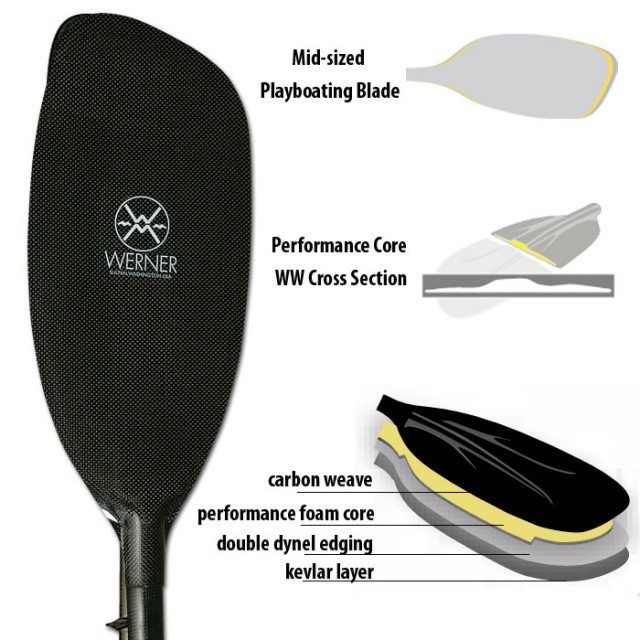David: I am all about fiberglass. I’ve seen too many carbon/foam core paddles break early on. Considering the extra cost of carbon/foam core paddles, this is a deal breaker for me. Sure, a fiberglass paddle will often fail early too, but at least you didn’t pay a premium for it.
On top of that, I haven’t found that the performance difference between the two justifies a $75-$100 price difference.
Tom: If you want durability, fiberglass is the way to go. Generally speaking, fiberglass paddles made, say, by Werner, do not have a tendency to break. The blades wear down over time, so eventually it will look like you have two ping-pong paddles for paddle blades, but I think a slow and steady decline is better than a catastrophic failure.
I have two fiberglass Werners—one of which I’ve used for almost 700 days—and I still use both of them. The blade surface area is not the same as it once was, but they still function very well.
Carbon is great for basically one thing—making light, stiff paddle blades and shafts. I have found some high-end, carbon paddle shafts to be too stiff and give me shoulder pain. But I really like carbon blades. They are incredibly stiff and have much lower swing weight.
Plastic paddles are great for folks new to paddling, since they work well in less demanding environments and are much cheaper. But I don’t like to use them, and I don’t recommend them to people who paddle more than 10 days a year.
Foam core paddles are interesting. There are basically three types of paddle cores:
1) No core (fiberglass with a stiffener).
2) Mid-core (a foam or balsa core that occupies the inner 30-50% of the blade).
3) Full foam core (the whole blade is built around a buoyant foam slab).

The type of core you use impacts the catch of the blade, and the blade’s “feel” in the water, otherwise known as buoyancy.
Since I prefer the quick aggressive catch of a blade with no foam core, but appreciate the buoyancy provided by foam, my ideal paddle is a mid-core blade. This is why I don’t like AT’s paddles—they use full foam core blades on all of their high-end paddles, which I find to have a very ‘mushy’ catch.
Jane: I have a fiberglass Werner that’s seen a lot of rock damage. More than once I’ve thought the paddle was cracked, only to find it was just fine.
To me, carbon isn’t worth the extra cost given the high probability that you’ll break or lose the paddle. My fiberglass paddle has stood up to everything I’ve thrown at it, and, other than the blades wearing down (I am down to the foam now), it is still a great paddle.
Finally, what’s the “best” angle of feather?
David: The idea of a feathered paddle developed for a few reasons that, in my opinion, don’t matter for most boaters anymore.
Feathered paddles came about so that slalom racers wouldn’t clip a gate with their top blade while doing tight eddy turns. They feathered their paddles at 90 degrees, and most of us have been using feathered paddles ever since. People also justify feathering a paddle by saying that it reduces wind drag. Personally, I don’t encounter these issues during everyday paddling.
That said, I use a 30-degree feather simply because it is what I am used to. I think anything between 30 degrees and 0 degrees works well for most creeking and river running needs. For playboating, I think that a 0-degree is the clear winner. A 0-degree ensures that your strokes are the same for tricks in both directions, and it’s especially useful for offside airscrews and back deck rolls.
I truly believe that we will see a shift in popularity toward 0-degree paddles in the near future.

Tom: I think David is spot on here—a 0-degree is the best for playboating, and whatever you’re used to is the best for other disciplines. Feather is the one area that I think has essentially no discernible performance change (with the exception of a 0-degree for playboating) and is entirely based on preference. I might expand the normal range to include 45 degrees, however.
As far as offset blades go, I have pretty limited personal experience (offset basically means the center of your blade does not line up with the center of your paddle shaft). You see this primarily on slalom specific or inspired paddles, and a number of pros who come from a slalom background bring these out onto creeks and rivers for everyday paddling and racing.
As far as I know, there are no American paddle companies producing paddles with significant offset. These basically fall into a niche designed for high-end racing, not unlike wing paddles for wildwater and surf skis or hand paddles for… They exist, people use them, but they are probably not the right choice for most paddlers as a primary paddle.
Jane: My paddle is 30 degrees, which is what I am used to. If I had two paddles, I would go for a smaller/no feather for playboating as I have experienced the occasional whiff during quick moves when my blade wasn’t fully rotated.
Thanks, all. We’ll leave it at that for now, and see whether or not our readers agree with you as they weigh in below.

What about blade size?